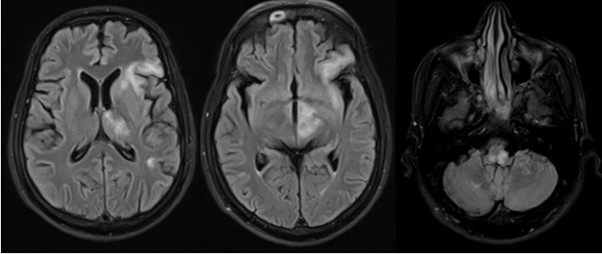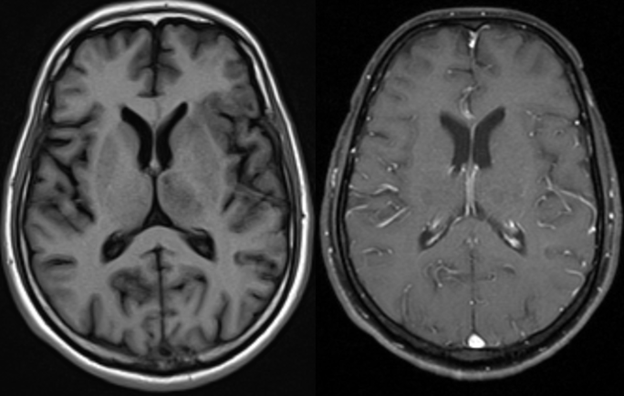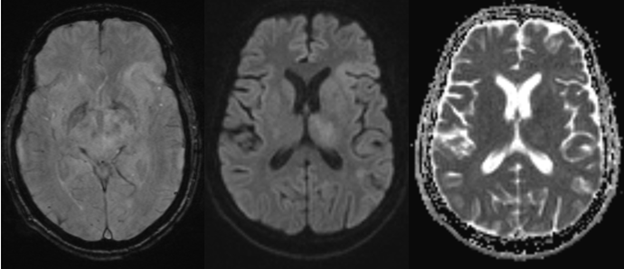A 39-year old male with complaint of right elbow pain since 3 months. No history of trauma.
- Axial T1w and T2w MRI demonstrate an accessory anconeus epitrochlearis muscle in the posterior-medial compartment of the right elbow.
- Axial T2w and Sagittal PDFS demonstrate that the ulnar nerve between the accessory muscle and the medial epicondyle is flattened and is compressed between the medial humeral epicondyle and accessory anconeus epitrochlearis muscle.
- Axial PDFS images at the level of accessory anconeus epitrochlearis muscle and at a section above it demonstrate increased intrasubstance signal and the nerve is mildly swollen and edematous with increased signal, just proximal to the level of compression. Mild focal fat stranding is seen in the overlying subcutaneous fat.
DIAGNOSIS:
Compressive neuropathy of the ulnar nerve at the elbow secondary to an accessory anconeus epitrochlearis muscle (Cubital tunnel syndrome).
DISCUSSION:
- Cubital tunnel syndrome is the most common type of ulnar nerve entrapment and is the second only to the carpal tunnel syndrome among upper limb compressive neuropathy.
- Ulnar neuropathy at the elbow is typically idiopathic. Several space-occupying lesions (e.g: ganglion cyst, osteophyte) and anomalous muscles have been described to cause ulnar nerve entrapment at the elbow.
- The anconeus epitrochlearis muscle is a congenital accessory muscle between the medial humeral epicondyle and the olecranon that covers the posterior aspect of the cubital tunnel. Ulnar nerve is compressed between anconeus epitrochlearis muscle and medial humeral epicondyle.
- Cadaveric, ultrasound, and magnetic resonance imaging (MRI) studies showed that the anconeus epitrochlearis muscle is a common variation, with a prevalence of up to 34%.
- Clinical presentation:
- Pain in medial elbow.
- Sensory loss in ulnar nerve distribution.
- Wasting of small muscles of hand.
- Ultrasonography is the initial imaging modality followed by MRI as necessary.
- Ultrasonography demonstrates thickened and edematous nerve with diffuse hypoechogenicity. A ratio of 1.5:1, comparing the ulnar nerve area at the level of cubital tunnel with that proximal to the level of cubital tunnel is seen.
- MRI demonstrates ulnar nerve thickening with increased T2 signal, reduction in perineural fat pad with neuropathic edema or atrophy of flexor carpi ulnaris and flexor digitorum profundus.
- The management of anconeus epitrochlearis induced ulnar neuropathy is conservative as well as surgical.
- The conservative management includes perineural injection of steroid and lidocaine. The surgical management includes excision of anconeus muscle8
REFERENCES:
- Nellans K, Galdi B, Kim HM, Levine WN. Ulnar neuropathy as a result of anconeus epitrochlearis. 2014; 37(8):e743- e745.
- De Maeseneer M, Brigido MK, Antic M, et al. Ultrasound of the elbow with emphasis on detailed assessment of ligaments, tendons, and nerves. Eur J Radiol. 2015; 84(4):671- 681.
- Wilson DH, Krout R. Surgery of ulnar neuropathy at the elbow: 16 cases treated by decompression without transposition. Technical note. J Neurosurg. 1973; 38(6):780-785.
Dr. Ashwini C. MD. FRCR.
Consultant Radiologist
Columbia Asia Radiology Group
Dr. Vivek J. MD.
Senior Resident and Cross-sectional fellow
Columbia Asia Radiology Group



